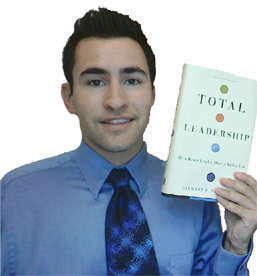About the author
Stewart Friedman has been on the Wharton faculty since 1984. He became the Management Department’s first Practice Professor in recognition of his work on the application of theory and research to the real challenges facing organizations. As founding director of the Wharton Leadership Program, in 1991 he initiated Wharton’s required MBA and undergraduate leadership courses. He also started and directs the Wharton Work/Life Integration Project; its mission is to develop leaders and enable change through action learning and applied research.
Stewart has consulted with a wide range of organizations and executives, including Jack Welch and Vice President Al Gore. His new book “Total Leadership” was an instant hit and today I’ll give you a sneak preview of the book.
Summary
In this book, Stewart lays out his blueprint for how to become a more successful and satisfied leader in all dimensions of life, including work, home, community and self (mind, body and spirit). What you will read in this book has been proven many times in Stewart’s classes. He offers a step-by-step “four-way wins” approach to produce sustainable, meaningful change that benefits all life domains by being real, being whole and being innovative. One of the attributes of a highly successful personal brand is leadership. Although you might not feel you’re a leader in the workplace, outside of work you just might be.
Success framework
1) Being real. Acting with authenticity by clarifying what’s important: Understanding how crucial events in the past have shaped one’s values and aspirations; assessing the relative importance of work, home, community and self; taking stock of how much time and energy is invested in each of these four domains; and diagnosing one’s level of satisfaction in each.
2) Being whole. Acting with integrity by respecting the whole person: Identifying the most important people in one’s life and their performance expectations, determining how different expectations affect one another, assessing how one sues different media for connecting with these key stakeholders, and preparing and conducting dialogues with each one to verify assumptions and see things through their eyes.
3) Being innovative. Acting with creativity by experimenting with new solutions: After seeing both what and who are important in a fresh light, designing and implementing small, smart, potent experiments that swiftly produce better results in all four parts of one’s life and that transform alienation, exhaustion, and resentment into feelings of purpose, authenticity, connection, and optimism.







